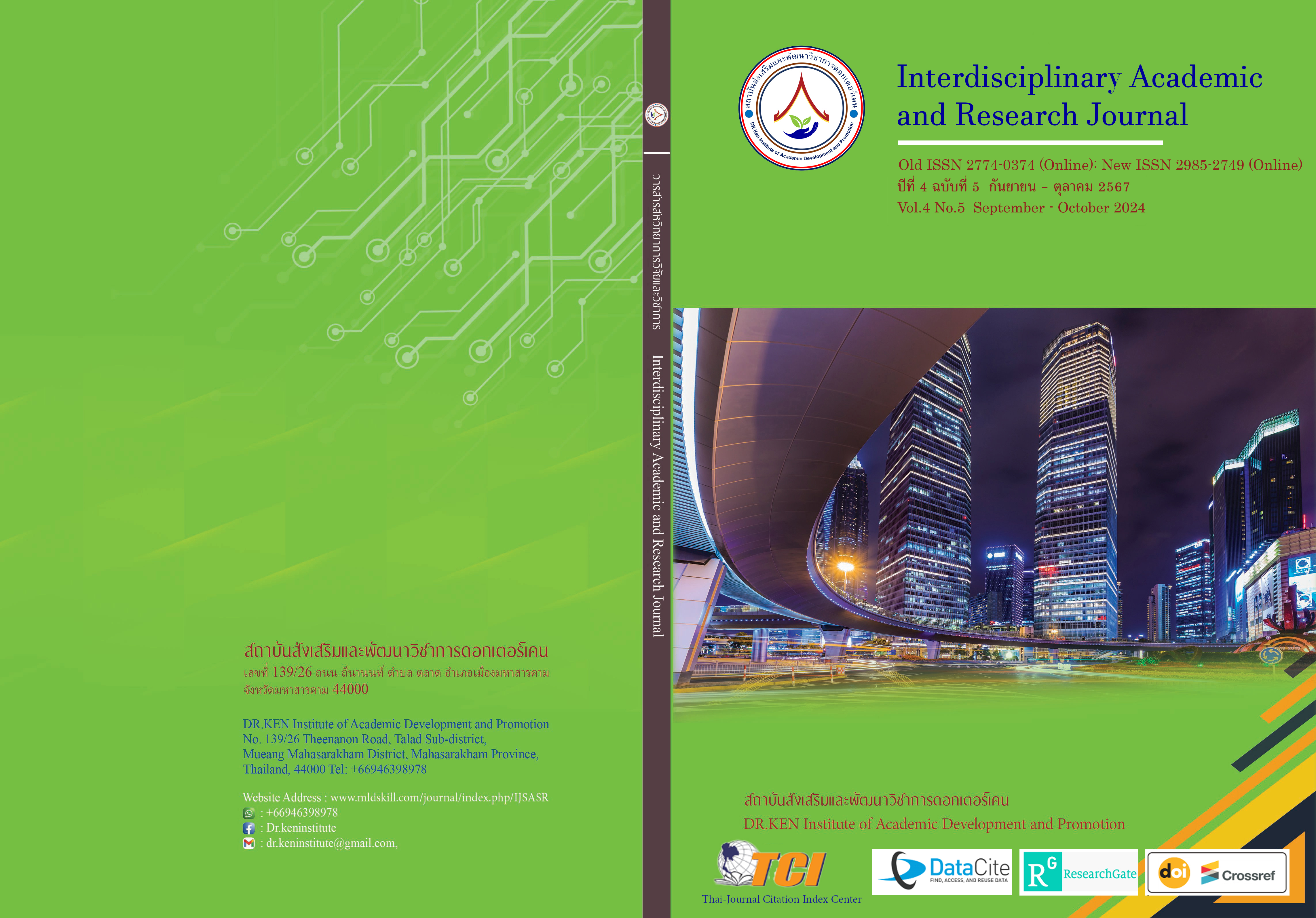Management of Student Discipline in Educational Institutions under the Jurisdiction of the Buriram Secondary Educational Service Area Office
DOI:
https://doi.org/10.60027/iarj.2024.276167Keywords:
Management; , Student DisciplineAbstract
Background and Aims: This research aims to: 1) study and compare the opinions of personnel regarding the management of student discipline in educational institutions under the Buriram Secondary Educational Service Area Office. By gender size of the educational institution and academic positions. And 2) explore ways to develop the management of student discipline in educational institutions under the Buriram Secondary Educational Service Area Office.
Methodology: The sample used in this research consisted of 349 personnel under the Buriram Secondary Educational Service Area Office, which were obtained by stratified random sampling. The research instrument consisted of a questionnaire with an IOC between 0.80 - 1.00 and a confidence value of 0.79. Including structured interviews for data analysis, statistics such as frequency, percentage, mean, and standard deviation were used T-test and F-test.
Results: The research results found that (1) Management of student discipline in educational institutions under the jurisdiction of the Buriram Secondary Educational Service Area Office, overall, it is at a high level. When considering each aspect, it was found that management in every aspect was at a high level as well. (2) Results of comparative analysis of management in creating student discipline Classified by gender and size of educational institution It was found that there was a statistically significant difference at the 0.05 level. As for classification by academic position, found that there was no difference. (3) Guidelines for developing management of student discipline in educational institutions under the Buriram Secondary Educational Service Area Office. It was found that the cause of the problem should be studied. Use culture in society to strengthen student discipline. Set and organize various extracurricular activities to strengthen student discipline. Strengthen morality within the classroom and create a network of cooperation to promote student discipline.
Conclusion: The study emphasizes the effectiveness of student discipline management in Buriram's educational institutions, demonstrating that overall management is strong in all areas. It also emphasizes the need for a cultural approach, extracurricular activities, and collaborative networks to improve student discipline while addressing identified areas for continuous improvement.
References
เกษรา เพิ่มสุขรุ่งเรือง และ ชุมศักดิ์ อินทร์รักษ์. (2563). การเสริมสร้างวินัยนักเรียนในโรงเรียนมัธยมศึกษา. วิทยานิพนธ์ดุษฎีบัณฑิต ภาควิชาการบริหารการศึกษาบัณฑิตวิทยาลัย มหาวิทยาลัยศิลปากร.
กระทรวงศึกษาธิการ. (2560). หลักสูตรแกนกลางการศึกษาขั้นนฐาน พุทธศักราช 2551 (ฉบับปรับปรุง 2560). กรุงเทพฯ : กระทรวงศึกษาธิการ.
ณัฐพงศ์ ดาราเพ็ญ. (2564). การศึกษาการมีส่วนร่วมของผู้ปกครองในกระบวนการเสริมสร้างระเบียบวินัยนักเรียน โรงเรียนเมืองศรีเทพ สังกัดสำนักงานเขตพื้นที่การศึกษามัธยมศึกษา เขต 40. วารสารครุศาสตร์, 4(1), 34 -50.
ธวาทิตย์ ทองทับ. (2565). ความต้องการจำเป็นในการบริหารงานกิจการนักเรียนโรงเรียนสังกัดเทศบาลตำบลปลายบาง จังหวัดนนทบุรี ตามแนวคิดการสร้างวินัยเชิงบวก. วารสาร มจร อุบลปริทรรศน์, 7(3), 767 -778
ธัญญลักษณ์ เวชกามา. (2560). การพัฒนาการดำเนินงานเสริมสร้างวินัยด้านความรับผิดชอบของนักเรียน โรงเรียนบ้านท่าเยี่ยมวิทยายล อำเภอเมืองยาง จังหวัดนครราชสีมา. วิทยานิพนธ์การศึกษามหาบัณฑิต สาขาการบริหารการศึกษา มหาวิทยาลัยนอร์ท กรุงเทพ.
ธีร์ธัช เกษโร. (2564). รูปแบบการบริหารกิจกรรมนักเรียนเพื่อเสริมสร้างวินัยนักเรียนด้านความรับผิดชอบของโรงเรียนในกลุ่มเครือข่ายสถานศึกษาที่ 1 สังกัดสำนักงานเขตพื้นที่การศึกษาประถมศึกษานครศรีธรรมราช เขต 3. วารสารบัณฑิตศึกษามหาจุฬาขอนแก่น, 8(3), 210 -221.
บุญชม ศรีสะอาด. (2553). การวิจัยเบื้องต้น. กรุงเทพฯ : สุวีริยาสาส์น.
สุรศักดิ์ เพ่งพิศ. (2565). การบริหารจัดการกิจกรรมพัฒนานักเรียนด้านความมีวินัยในตนเองของโรงเรียนในสังกัดสำนักงานเขตพื้นที่การศึกษามัธยมศึกษาสุรินทร์. วารสารสถาบันวิจัยและพัฒนา มหาวิทยาลัยราชภัฏมหาสารคาม, 9(1), 503 – 512.
Krejcie, R. V., & Morgan, D. W. (1970). Determining sample size for research activities. Educational and Psychological Measurement, 30(3), 607–610.
Downloads
Published
How to Cite
Issue
Section
License
Copyright (c) 2024 Interdisciplinary Academic and Research Journal

This work is licensed under a Creative Commons Attribution-NonCommercial-NoDerivatives 4.0 International License.
Copyright on any article in the Interdisciplinary Academic and Research Journal is retained by the author(s) under the under the Creative Commons Attribution-NonCommercial-NoDerivatives 4.0 International License. Permission to use text, content, images, etc. of publication. Any user to read, download, copy, distribute, print, search, or link to the full texts of articles, crawl them for indexing, pass them as data to software, or use them for any other lawful purpose. But do not use it for commercial use or with the intent to benefit any business.
















.png)


